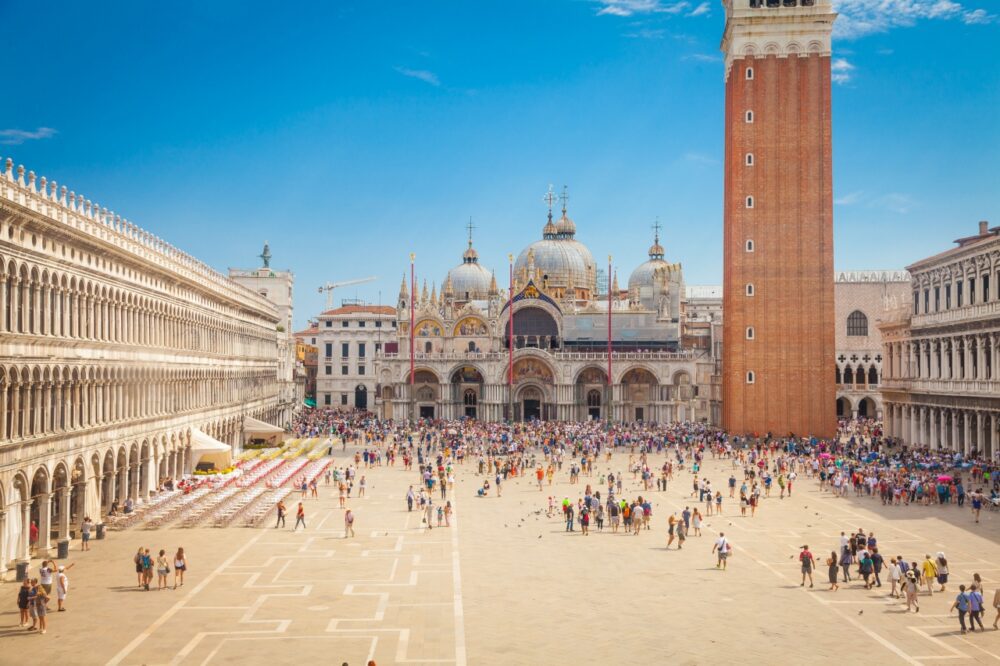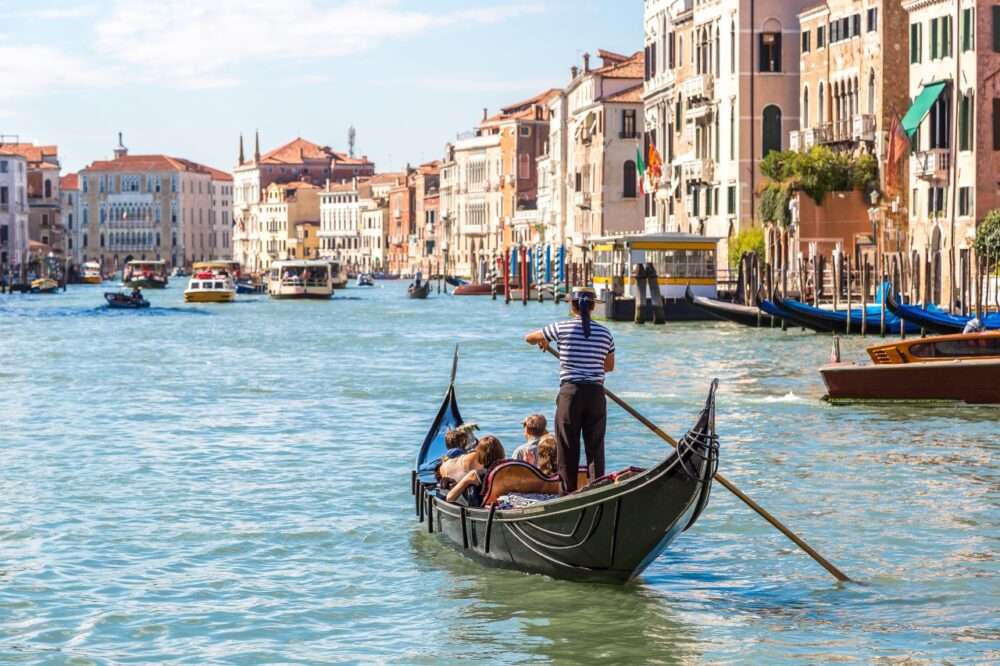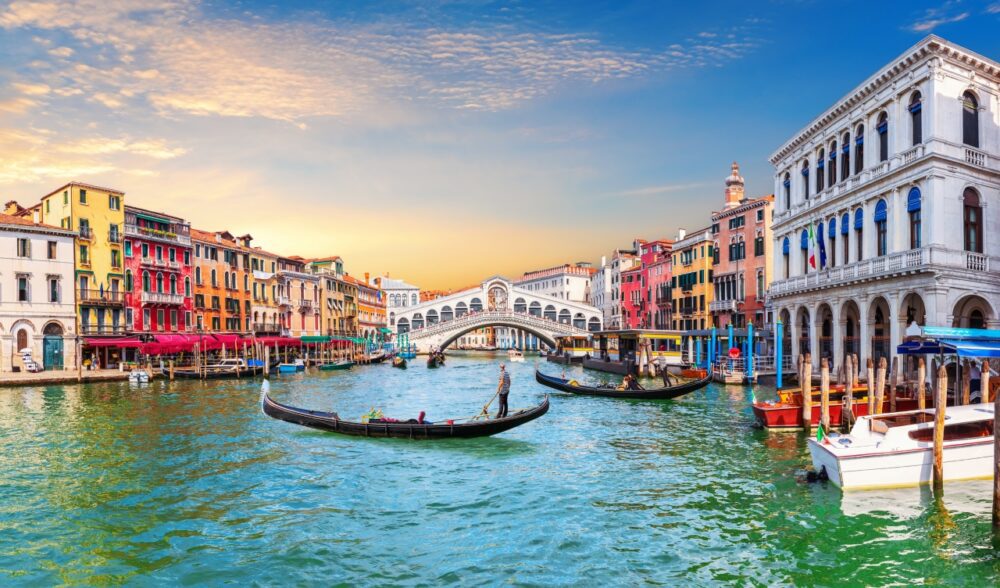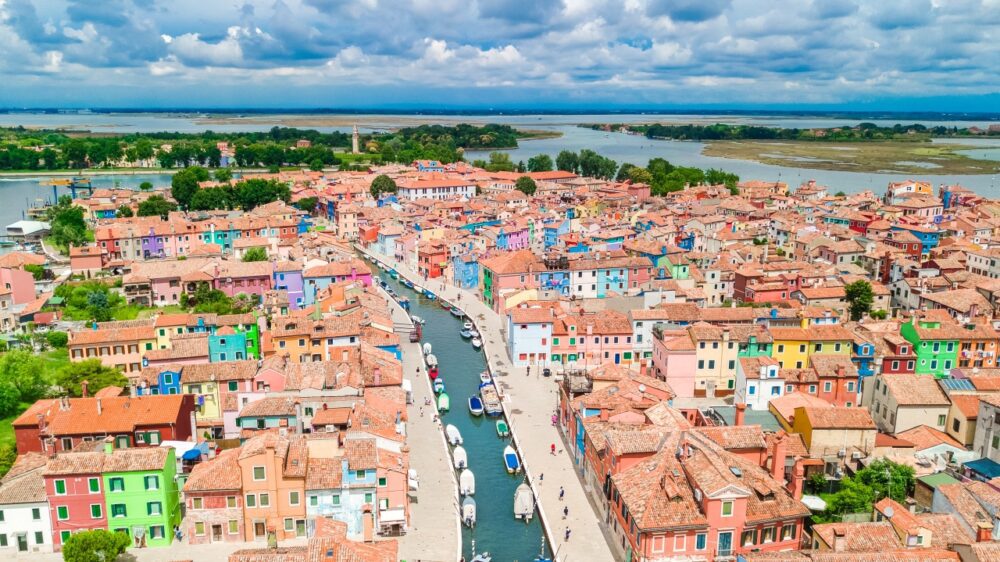
Is Venice worth visiting? Without a doubt! The first time I arrived in Venice, stepping off the vaporetto and onto its iconic canals, I felt like I’d entered a dream. From gliding along the Grand Canal in a gondola to wandering through the maze of narrow streets and charming bridges, Venice left me spellbound. There’s a reason why this floating city has inspired artists, writers, and travellers for centuries.
Located in northeastern Italy, Venice is a city like no other. Built on a network of islands, its waterways serve as streets, making it a uniquely magical place to explore. Famous for its stunning St. Mark’s Basilica, the Doge’s Palace, and the bustling Rialto Market, Venice is a city that seamlessly blends history, art, and romance. Whether you’re sipping a spritz in a sunny piazza, admiring intricate Murano glass, or getting lost in its quiet back alleys, Venice is a destination that feels timeless.
But is Venice worth visiting for you? In this blog post, we’ll uncover the top 10 reasons why Venice should be on your travel list, from its world-famous landmarks to its hidden treasures. Plus, we’ll share tips to help you navigate the city and avoid common pitfalls. Keep reading to discover why Venice is one of Italy’s most enchanting destinations.
Table of Contents
Pros – Reasons You Should Visit Venice
1. Unique and Stunning Architecture

Venice is unlike any other city in the world. Built on more than 100 islands connected by bridges and canals, it’s a masterpiece of engineering and design. The Piazza San Marco, Doge’s Palace, and Rialto Bridge are just a few of the architectural gems that make Venice a visual feast.
I remember standing in Piazza San Marco at sunset, watching the light play off the golden mosaics of St. Mark’s Basilica. It’s a moment that stays with you. Exploring the winding streets and waterways reveals countless hidden treasures, from ornate churches to quaint courtyards. Venice’s architecture alone makes it worth visiting.
2. Iconic Gondola Rides

No trip to Venice is complete without a gondola ride. Gliding through the canals in one of these traditional boats is a quintessential Venetian experience and offers a unique perspective of the city.
I took a gondola ride just as the sun was setting, and it was magical. The gondolier sang softly as we passed under ancient bridges and alongside centuries-old buildings. It’s undeniably touristy, but it’s also incredibly atmospheric. If you’re travelling with a partner, it’s one of the most romantic things you can do in Venice.
3. Rich History and Cultural Heritage

Venice was once a powerful maritime republic, and its history is woven into every stone. Visiting landmarks like the Doge’s Palace and the Bridge of Sighs brings the city’s past to life, while museums like the Correr Museum delve deeper into its fascinating story.
Walking through the Doge’s Palace was like stepping into the pages of a history book. The opulence of the chambers and the chilling dungeons tell a story of power and intrigue. History buffs will find plenty to love in Venice, from its role in the Renaissance to its maritime dominance.
4. Vibrant Art Scene
Venice has been a hub for art and creativity for centuries. The Peggy Guggenheim Collection is a must-visit for modern art lovers, while the Venice Biennale attracts artists and enthusiasts from around the globe. The city itself feels like a work of art.
I was blown away by the Guggenheim Collection, housed in a stunning palazzo on the Grand Canal. The mix of modern masterpieces and the setting made it a highlight of my trip. Even if you’re not an art aficionado, Venice’s artistic legacy is impossible to ignore, and it’s woven into every corner of the city.
5. World-Famous Cuisine
Venice offers a culinary experience like no other, with its focus on fresh seafood and traditional Venetian dishes. From sarde in saor (sweet and sour sardines) to risotto al nero di seppia (squid ink risotto), the flavours are unique and unforgettable.
I had an incredible meal at a small trattoria in Cannaregio, where the seafood was so fresh it felt like it had just been caught. Don’t forget to try Venetian cicchetti—bite-sized snacks similar to tapas—paired with a glass of local wine or spritz, the city’s signature aperitif.
6. The Grand Canal

The Grand Canal, Venice’s main waterway, is an unforgettable sight. Lined with historic palaces and bustling with vaporettos (water buses) and gondolas, it’s the city’s lifeline and one of its most iconic features.
I took a vaporetto ride along the Grand Canal at dusk, and the view was breathtaking. The palaces lit up as the sky turned pink, creating a picture-perfect moment. A ride along the Grand Canal is a must-do, and it’s an affordable way to see Venice from the water.
7. Burano and Murano Day Trips

Venice’s nearby islands, Burano and Murano, offer a different perspective on Venetian life. Burano is known for its colourful houses and lace-making tradition, while Murano is famous for its exquisite glasswork.
I took a half-day trip to both islands, and it was a welcome escape from the crowds of Venice. Watching glassblowers at work in Murano was fascinating, and Burano’s rainbow-hued streets felt like a postcard come to life. If you have time, these islands are well worth the trip.
8. Romantic Atmosphere
Venice is one of the most romantic cities in the world, with its serene canals, candlelit restaurants, and intimate gondola rides. It’s a popular destination for couples and honeymooners for good reason.
One evening, I shared a bottle of wine on a quiet dock with a view of the Grand Canal. The city has a way of making even the simplest moments feel magical. Whether it’s a stroll through Piazza San Marco or a quiet dinner by the water, Venice oozes romance.
9. Festivals and Events
Venice hosts some of the world’s most famous festivals, including the Venice Carnival and the Venice Film Festival. These events bring a vibrant energy to the city and offer unique experiences for visitors.
I was lucky enough to visit during the Carnival, and the elaborate masks and costumes added a magical touch to the city. The streets were alive with music and festivities, making it a truly unforgettable experience. If you can time your visit with a festival, it adds an extra layer of excitement.
10. A Photographer’s Dream
Every corner of Venice is photogenic, from its iconic landmarks to its hidden alleys. The city’s light, reflections, and unique architecture make it a paradise for photographers.
I found myself constantly stopping to take photos, whether it was of a gondola gliding past or the reflection of a pastel building in the canal. Venice is one of those cities where every shot feels like a masterpiece, so don’t forget your camera.
Cons – Things to Consider When Visiting Venice
1. Overcrowding
Venice is one of the most visited cities in the world, and its narrow streets and popular attractions can feel overcrowded, especially during peak tourist seasons.
When I visited in July, Piazza San Marco was so packed it was hard to enjoy the view. If you want a quieter experience, consider visiting in the off-season, like winter or early spring. Exploring early in the morning or late in the evening also helps you avoid the worst of the crowds.
2. Expensive Accommodation and Dining
Venice’s popularity comes with a price tag. Hotels, especially those near the Grand Canal, can be very expensive, and dining out in touristy areas often comes with inflated prices.
I stayed in the Cannaregio neighbourhood, which was more affordable and had a local vibe. To save on meals, I sought out smaller trattorias away from the main tourist hubs. Venice can be pricey, but with a little planning, it’s possible to enjoy the city without breaking the bank.
3. Limited Nightlife
Venice’s nightlife is quieter than in other Italian cities, focusing more on relaxed evenings than lively parties. While there are wine bars and restaurants, options for late-night activities are limited.
I enjoyed a quiet drink by the Grand Canal one evening, but if you’re looking for a buzzing nightlife scene, Venice might not be the place. That said, the peaceful atmosphere at night adds to the city’s charm.
4. Flooding and High Water (Acqua Alta)
Venice is prone to flooding, particularly during the winter months, when acqua alta (high water) can make navigating the city challenging. Elevated walkways are set up, but it can disrupt your plans.
I experienced minor flooding during my visit, and while it didn’t ruin my trip, it’s worth checking the forecast and being prepared. Bring waterproof shoes or boots if you’re visiting in the wetter months.
5. Touristy Atmosphere
With millions of visitors each year, parts of Venice can feel overly commercialized. Souvenir shops and tourist traps are common, and some areas lose their authentic charm.
I found that venturing into less-touristy neighbourhoods like Dorsoduro offered a more genuine experience. While Venice is undeniably popular, there are quieter corners where you can escape the crowds and enjoy the city’s true spirit.
When to Visit Venice
The best times to visit Venice are spring (April to June) and autumn (September to October), when the weather is mild, and the canals and piazzas are less crowded than in peak summer. These seasons showcase Venice at its most charming, with blooming flowers or soft autumn light adding to the romantic atmosphere. Summer (July and August) can be hot and crowded, though it’s still a popular time for gondola rides and festivals like the Venice Film Festival. Winter is quieter, with fewer tourists, and February’s Carnival transforms the city into a lively celebration of masks and costumes, perfect for those seeking cultural excitement.
How to Get to Venice
Venice is served by Marco Polo Airport (VCE), located about 8 kilometres from the city. The Alilaguna water buses connect the airport to Venice’s main islands, offering a scenic way to arrive. Alternatively, land buses or taxis go to Piazzale Roma, from where you’ll transfer to water transport. The smaller Treviso Airport (TSF) caters to budget airlines like Ryanair and is about an hour from Venice by shuttle bus. Venice is also accessible by train, with Santa Lucia Station on the Grand Canal offering connections via Trenitalia to major cities like Milan, Florence, and Rome.
Where to Stay in Venice
Venice has a variety of neighbourhoods offering distinct atmospheres and accommodation options:
- Luxury: San Marco – Close to iconic sights like St. Mark’s Basilica and the Doge’s Palace. Stay at Hotel Danieli or The Gritti Palace, which offer opulent Venetian charm and unbeatable views of the Grand Canal.
- Mid-range: Cannaregio – A quieter district with authentic local character and easy access to main attractions. Consider Hotel Antico Doge or Ca’ Gottardi, which blend comfort and style at a reasonable price.
- Budget: Dorsoduro – Popular with students and artists, this area is lively but less crowded. Options like Locanda Ca’ Zose or Generator Venice provide affordable stays with plenty of charm.
Getting Around Venice
Venice is a pedestrian’s paradise, with no cars or buses on its islands. Most of the city’s main attractions are within walking distance, making it easy to explore on foot. For longer distances or scenic routes, the vaporetto (water bus) is the primary mode of transport, with single tickets or day passes available. Gondolas are more of a romantic splurge than a practical way to get around, but they’re iconic nonetheless. Venice doesn’t have a bike-sharing scheme since bikes aren’t allowed in the historic centre, but ferries make exploring nearby islands like Murano and Burano simple and budget-friendly.
How Long to Spend in Venice
Two to three days is ideal for exploring Venice’s highlights, including St. Mark’s Basilica, the Doge’s Palace, the Rialto Bridge, and a gondola ride along the Grand Canal. This timeframe allows you to wander through quieter neighbourhoods like Cannaregio or Dorsoduro and sample Venetian cuisine in local bacari. With an extra day, take a boat trip to the nearby islands of Murano, famous for its glassmaking, and Burano, known for its colourful houses. If time allows, consider a day trip to Torcello or the Venetian Lagoon for a deeper dive into the region’s history and charm.
Conclusion
So, is Venice worth visiting? Absolutely! With its breathtaking canals, rich history, and romantic atmosphere, Venice is a city that delivers unforgettable experiences. Highlights like St. Mark’s Square, the Grand Canal, and the city’s unique charm make it a must-visit. While it can be crowded and pricey, Venice’s beauty and one-of-a-kind allure make it worth every effort. If you’re ready to fall in love with Italy’s floating masterpiece, start planning your trip to Venice today—you’ll never forget it!
